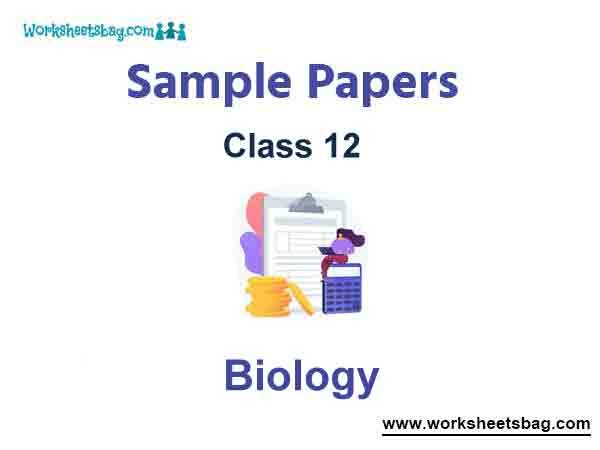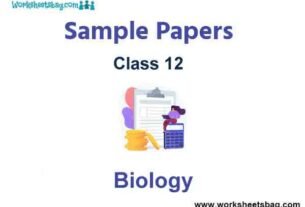Please refer to the Class 12 Biology Sample Paper for the current academic year given below. We have provided the latest CBSE Sample Papers for Term 1 and Term 2 for Biology Class 12. All guess sample papers have been prepared based on the latest blueprint and examination pattern for the current year. All sample papers for Biology Class 12 Term 1 and 2 have been given with solutions. Students can access the multiple guess papers given below. Practicing more Class 12 Biology Sample Papers will help you to get more marks in upcoming exams.
CBSE Sample Papers for Class 12 Biology
| Sample Papers for Class 12 Biology |
| Class 12 Biology Sample Paper Set A |
| Class 12 Biology Sample Paper Set B |
| Class 12 Biology Sample Paper Set C |
| Term 2 Sample Papers for Class 12 Biology |
| Class 12 Biology Sample Paper Term 2 Set A |
| Class 12 Biology Sample Paper Term 2 Set B |
Class 12 Biology Sample Paper Term 2 Set A
SECTION – A
1. Name the first restriction endonuclease isolated and also give its recognition sequence.
Answer : The first restriction endonuclease isolated was Hind II. Its recognition sequence is
↓
5′ – G – T – C – G – A – C – 3′
3′ – C – A – G – C – T – G – 5′
↑
2. Name the type of biodiversity represented by the following:
(i) 50,000 different strains of rice in India
(ii) Estuaries and alpine meadows in India.
Answer : (i) 50,000 different strains of rice in India represent genetic diversity.
(ii) Estuaries and alpine meadows in India represent ecological diversity.
3. Why is tropical environment able to support greater species diversity?
Answer : Continuous favourable environment with little seasonal changes of temperature and moisture supports greater species diversity in tropical areas. Also, more solar energy is available in tropics, which promotes higher productivity and increased biodiversity.
4. How do seed bearing plants tide over dry and hot weather conditions?
Answer : Mesophytic seed bearing plants sometimes have to face hot and dry weather conditions. They survive such adverse conditions by forming underground perennating structures such as corms, rhizomes, tubers, etc. Xerophytic plants on the other hand have to face hot and dry conditions throughout the year. They show various adaptations like sunken stomata, fleshy organs, leaves reduced to spines, extensive root system, etc.
5. Assertion : All immunoglobulin molecules have a basic structure composed of four polypeptide chains.
Reason : The polypeptide chains consists of two identical heavy and light chains connected by disulphide bonds.
(a) Both assertion and reason are true, and reason is the correct explanation of assertion.
(b) Both assertion and reason are true, but reason is not the correct explanation of assertion.
(c) Assertion is true but reason is false.
(d) Assertion is false but reason is true.
Answer : (b)
6. Assertion : Amylases are used for clearing turbidity in juices caused by starch.
Reason : Amylases degrade starch.
(a) Both assertion and reason are true, and reason is the correct explanation of assertion.
(b) Both assertion and reason are true, but reason is not the correct explanation of assertion.
(c) Assertion is true but reason is false.
(d) Assertion is false but reason is true.
Answer : (a)
OR
Assertion : Intercropping checks the population of insects.
Reason : Plant pests can be controlled biologically by their natural parasites and pathogens.
(a) Both assertion and reason are true, and reason is the correct explanation of assertion.
(b) Both assertion and reason are true, but reason is not the correct explanation of assertion.
(c) Assertion is true but reason is false.
(d) Assertion is false but reason is true.
Answer : (b)
7. Read the following passage and answer questions from 7(i) to 7(v) given below:
Reema, Jai and Ankit are suffering from autoimmune diseases of adrenal cortex, joints and thyroid gland, respectively. Their immune system failed to recognise self and non-self and started destroying their body’s own proteins. They are seeking proper medical help for their conditions but their condition cannot be cured completely.
(i) Select the option that correctly identifies autoimmune diseases of Reema, Jai and Ankit.
Reema Jai Ankit
(a) Diabetes Grave’s disease Rheumatic fever
(b) Pernicious anaemia Multiple sclerosis Myasthenia gravis
(c) Addison’s disease Rheumatoid arthritis Hashismoto’s thyroiditis
(d) Systemic lupus erythematosus Severe combined immunodeficiency disease AIDS
Answer : (c)
(ii) Reema’s autoimmune condition is characterised by
(a) undersecretion of insulin
(b) destruction of RBCs and low RBC count
(c) undersecretion of adrenal cortex hormones
(d) low production of intrinsic factor required for absorption of B12.
Answer : (c)
(iii) What do you think is the major cause of Jai’s condition?
(a) Deterioration of myelin sheath around nerve cells leading to loss of precise muscle control.
(b) Destruction of heart cells leading to weakening of entire heart wall.
(c) Destruction of beta cells leading to undersecretion of insulin.
(d) Deposition of immune complexes of IgM, IgG and complement in joints thereby inflaming joints,destroying articular cartilage and fusing bones.
Answer : (d)
(iv) How do you think Ankit’s condition got diagnosed?
(a) Low level of thyroid hormone and elevated levels of TSH in Ankit’s blood.
(b) Presence of antibodies against thyroid pen oxidase (TPO antibodies) in Ankit’s blood.
(c) Elevated erythrocyte sedimentation rate (ESR), reduced C-reactive protein (CRP) in Ankit.
(d) Both (a) and (b)
Answer : (d)
(v) Read the given statements and select the correct option.
Statement 1 : Immunosuppressive drugs often reduce the severity of autoimmune disorders.
Statement 2 : Monoclonal antibodies have been successfully used in the treatment of autoimmune disease.
(a) Both statement 1 and statement 2 are true
(b) Statement 1 is true but statement 2 is false.
(c) Statement 1 is false but statement 2 is true.
(d) Both statement 1 and statement 2 are false.
Answer : (a)
SECTION – B
8. Explain the method to increase the competency of the bacterial cell membrane to take up recombinant DNA?
Answer : The recombinant DNA can be forced into the bacterial cell treated with divalent cations and incubating it with recombinant DNA on ice. This is to be followed by placing it briefly at 42°C (heat shock), and then putting it back on ice. This process would enable the bacteria to take up the recombinant DNA.
OR
What are bioreactors? How are large volumes of cultures maintained and processed in them?
Answer : Bioreactors are vessels in which raw materials are biologically converted into specific products such as enzymes using microbial, plant, animal or human cells. Large scale production (100-1000 L) of the products is carried out in bioreactors. A bioreactor provides the optimal conditions for achieving the desired product by providing optimum growth conditions like temperature, pH, substrate, salts, vitamins and oxygen.
9. Name the source of cyclosporin-A. How does this bioactive molecule function in our body?
Answer : Cyclosporin A is an eleven membered cyclic oligopeptide obtained through fermentive activity of fungus Trichoderma polysporum. It has antifungal, anti-inflammatory and immunosuppressive properties. It inhibits activation of T cells and therefore prevents rejection reactions in organ transplantation.
10. Name the parasite that causes filariasis in humans. Mention its two diagnostic symptoms. How is this disease transmitted to others?
Answer : Filariasis is a helminthic disease caused by Wuchereria (W. bancrofti and W. malayi). It causes swelling of lymphatic vessels of lower limbs resulting in swelling of feet, legs, scrotal sacs and thighs. It spreads from one human being to other through the bite of female mosquito, Culex.
11. Differentiate between parasitism and competition, giving one example of each. State the common characteristic they share.
Answer : (Table 133)
Both parasitism and competition are negative population interactions. In parasitism, one organism (parasite) has negative effect on other organism (host) and in competition, both species are negatively affected.
SECTION-C
12. Refer to the given flow chart and answer the following questions. (Image 132)
(i) Identify the missing parts A and B.
(ii) What is the optimum temperature at which the above mentioned process occur and the role of bacteria in the process?
Answer : (i) A – Lactic acid; B – Vitamin B12
(ii) Indian curd is prepared by inoculating skimmed and cream milk with Lactobacillus acidophilus at a temperature of about 40°C or less. Lactic acid bacteria (LAB) like Lactobacillus are added to milk. It converts lactose sugar of milk into lactic acid. Lactic acid causes coagulation and partial digestion of milk protein casein and milk is then converted into curd, yoghurt or cheese using different processes.
13. Explain the role of selectable markers in cloning.
Answer : Selectable markers are the genes that help in selecting those host cells which are transformed while eliminating the non-transformants. Transformation is a process through which a piece of DNA is introduced in host bacterium. Generally, the genes encoding resistance to antibiotics such as tetracycline, ampicillin, kanamycin or chloramphenicol, etc., are useful selectable markers for E. coli. The common E. coli cells are not resistant against any of these antibiotics. Plasmid pBR322 has two resistance genes — ampicillin resistance (ampR) and tetracycline resistance (tetR) which are considered as useful for selectable markers.
OR
Describe any six advantages of genetically modified plants.
Answer : Applications of genetically modified plants are as follows:
(i) These plants are resistant to (a) diseases resulting from viral, bacterial and fungal infections (b) pests, such as nematodes and insects and (c) pesticides.
(ii) They can tolerate adverse abiotic stresses such as cold, drought, salt, heat, etc.
(iii) They show increased efficiency of mineral usage (this prevents early exhaustion of fertility of soil).
(iv) GM plants have high nutritional value, e.g., vitamin A enriched rice.
(v) Plants such as poplar (Populus) trees have been genetically engineered to clean up heavy pollution from contaminated soil.
(vi) These plants helped to reduce post harvest losses, e.g., Flavr Savr transgenic tomato.
SECTION-D
14. (a) With the help of diagrams show the different steps in the formation of recombinant DNA by action of restriction endonuclease enzyme EcoRI.
(b) Name the technique that is used for separating the fragments of DNA cut by restriction endonucleases.
Answer : (a) Steps in the formation of recombinant DNA by action of restriction enzyme EcoRI
(b) After the cutting of DNA by restriction enzyme, fragments of DNA are formed. Separation of DNA fragments according to their size or length is done by a technique called agarose gel electrophoresis. It is a technique of separation of molecules such as DNA, RNA or protein, under the influence of an electrical field, so that they migrate in the direction of electrode bearing the opposite charge, viz., positively charged molecules move towards cathode (–ve electrode) and negatively charged molecules travel towards anode (+ve electrode) through a medium/matrix. Most commonly used matrix is agarose. DNA fragments separate according to their sizes through the pores of agarose gel. Hence the smaller, the fragment size, the farther it moves. The separated DNA fragments can be seen only after staining the DNA with a compound known as ethidium bromide (EtBr) followed by exposure to UV radiation. The fragments are visible as bright orange coloured bands.
OR
Unless the vector and source DNA are cut, fragments separated and joined, the desired recombinant vector molecule cannot be created.
(a) How are the desirable DNA sequences cut?
(b) Explain the technique used to separate the cut fragments.
(c) How are the resultant fragments joined to the vector DNA molecule?
Answer : (a) Desirable DNA sequences are cut by the use of enzyme restriction endonuclease. The restriction enzymes cut the strand of DNA a little away from the centre of the palindromic sites, between the same two bases on the opposite strands, it leaves single stranded portions at the ends. This forms overhanging stretches called sticky ends on each strand. They are called sticky as they form hydrogen bonds with their complementary cut counterparts. The stickiness of the ends facilitates the action of the enzyme DNA ligase.
(b) Refer to answer 14(b).
(c) DNA ligase help to join resultant fragments to the vector DNA molecule. DNA ligases join two individual fragments of double stranded DNA by the formation of phosphodiester bond between them.
15. (a) Name the population growth pattern the equation dN dt { = rN}represents.
What does “r” represent in the equation? Write its importance in population growth.
(b) Explain the principle of carrying capacity by using Verhulst-Pearl logistic growth curve.
Answer : (a) The equation dN /dt = rN, represents exponential
growth form. ‘r’ represents intrinsic rate of natural increase. It is a very important parameter chosen for assessing impacts of any biotic or abiotic factor on population growth. Its value depends upon the birth rates and death rates.
(b) In nature, a given habitat has resources to support a certain number of individuals of a populat i on ,beyond which no further growth is possible. This limit is cal led nature’s (Image 135) carrying capacity (K) for that species in that habitat.
OR
(a) Following are the responses of different animals to various abiotic factors. Describe each one with the help of an example.
(i) Regulate (ii) Conform (iii) Migrate
(b) If 8 individuals in a population of 80 butterflies die in a week, calculate the death rate of population of butterflies during that period.
Answer : (a) (i) Regulate : The organisms which can maintain a constant body temperature and constant osmotic concentration despite changes in the external environment are called regulators, such as human beings, birds, etc. They possess homeostasis mostly through thermoregulation and osmoregulation by physiological adjustments and rarely by behavioural changes. They have a wide range of distribution and are more active. For example, we maintain a constant body temperature of 37 °C. In summer, when outside temperature is more than our body temperature, we sweat profusely. The resulting evaporative cooling, similar to what happens with a desert cooler in operation, brings down the body temperature. In winter, when the temperature is much lower than 37 °C, we start to shiver, a kind of exercise which produces heat and raises the body temperature.
(ii) Conform : Some organisms conform to their external environment because they cannot maintain homeostasis internally, hence, they are called conformers. Their body temperature and osmotic concentration change according to their surroundings. They have a narrow range of distribution and consume lesser energy. E.g., in aquatic animal Asterias, the osmotic concentration of body fluids changes according to the osmotic concentration of the surrounding water.
(iii) Migrate : Under unfavourable conditions, some organisms migrate to more favourable areas and return when the conditions are less hostile. The movement can be in search of food, climate, etc. Many animals, specially birds, migrate during winters to more favourable areas e.g., Arctic tern, Sea lamprey, etc. Every winter the Keoladeo National Park (Bharatpur) in Rajasthan receives thousands of migratory birds which comes from Siberia and other very cold northern regions.
(b) Death rate is defined as the number of deaths per 1000 individuals of a population. Since, total number of butterflies = 80, Number of butterflies that died = 8
Death rate = 8/80 = 0.1 butterflies per week.


